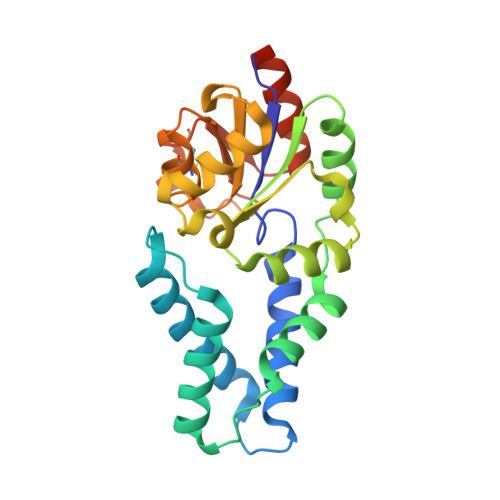Design and evolution of an enzyme with a non-canonical organocatalytic mechanism.
Burke, A.J., Lovelock, S.L., Frese, A., Crawshaw, R., Ortmayer, M., Dunstan, M., Levy, C., Green, A.P.(2019) Nature 570: 219-223
- PubMed: 31132786
- DOI: https://doi.org/10.1038/s41586-019-1262-8
- Primary Citation of Related Structures:
6Q7N, 6Q7O, 6Q7P, 6Q7Q, 6Q7R - PubMed Abstract:
The combination of computational design and laboratory evolution is a powerful and potentially versatile strategy for the development of enzymes with new functions 1-4 . However, the limited functionality presented by the genetic code restricts the range of catalytic mechanisms that are accessible in designed active sites. Inspired by mechanistic strategies from small-molecule organocatalysis 5 , here we report the generation of a hydrolytic enzyme that uses N δ -methylhistidine as a non-canonical catalytic nucleophile. Histidine methylation is essential for catalytic function because it prevents the formation of unreactive acyl-enzyme intermediates, which has been a long-standing challenge when using canonical nucleophiles in enzyme design 6-10 . Enzyme performance was optimized using directed evolution protocols adapted to an expanded genetic code, affording a biocatalyst capable of accelerating ester hydrolysis with greater than 9,000-fold increased efficiency over free N δ -methylhistidine in solution. Crystallographic snapshots along the evolutionary trajectory highlight the catalytic devices that are responsible for this increase in efficiency. N δ -methylhistidine can be considered to be a genetically encodable surrogate of the widely employed nucleophilic catalyst dimethylaminopyridine 11 , and its use will create opportunities to design and engineer enzymes for a wealth of valuable chemical transformations.
- Manchester Institute of Biotechnology, School of Chemistry, University of Manchester, Manchester, UK.
Organizational Affiliation:

















